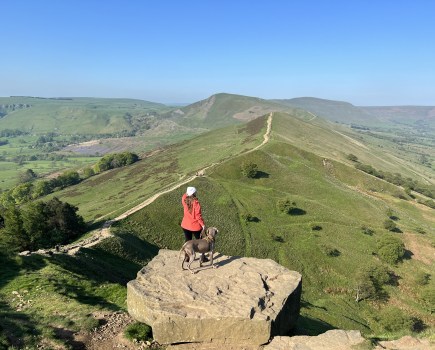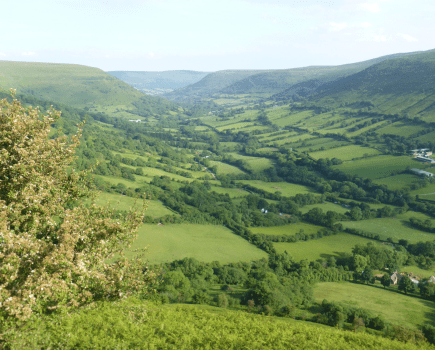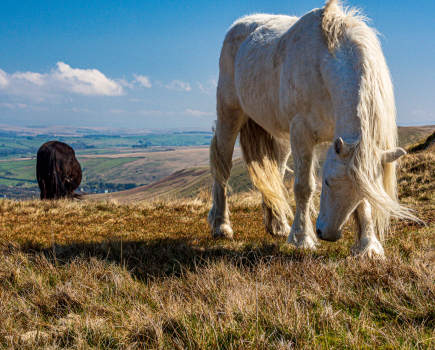Vivienne Crow charts a Black Combe walk in little-visited hills.
At 14km/9 miles, 814m/2670ft of ascent, and taking about 5 hours, this is a moderate hillwalk on the edge of the Lake District. Way down in the far south-west corner of Lakeland is a small group of rounded, generally grassy fells with a character all of their own. Lacking the harsh outlines of the Borrowdale volcanics found in the high fells of the central Lake District, these hills have more in common with the Northern Fells group. Composed of Skiddaw slates, they are among the oldest mountains in the region, laid down by sedimentary processes almost 500 million years ago. Standing alone though, isolated from their northern brethren and with the waters of Morecambe Bay and the Irish Sea encroaching on three sides, they have an air of distinctiveness, exclusivity even, about them.
Over the years, writers have picked up on this uniqueness, singling out the highest point, Black Combe, for particular attention. Branwell Brontë, brother to the famous literary sisters, said the fell was formed “to fight 1,000 years of struggles with a storm”. From its summit, said Wordsworth, “the amplest range of unobstructed prospect may be seen that British ground commands”. And, more recently, local poet Norman Nicholson famously observed: “When you can see Black Combe, we say in Millom, it’s going to rain, when you can’t see it, it’s raining already.”
Whitecombe Moss
Despite them being Cumbria’s first line of defence against the prevailing south-westerlies, I’ve never yet experienced bad weather on these hills. On previous visits, I’d approached Black Combe via the path rising north, directly from Whicham. It’s a reasonably popular route, used by many as a there-and-back way on to the fell. On my last visit, however, I decided it was about time I explored a little more of this neglected group.
Looking for some good footwear for the hills? Read our review of the Inov-8 Roclite Pro G 400 Gore-Tex boots!
From St Anne’s Church at Hallthwaites, we crossed farmland and rough grazing before we could step up on to the southern flanks of Gray Stones, a 396m hill on the eastern edge of the huddle. Behind, the River Duddon snaked its way out into the calm waters of Morecambe Bay, while standing out on the horizon was Blackpool Tower. From the top of Stoupdale Crags, we negotiated a route through boggy Whitecombe Moss. The west coast had appeared now, with the hills of Dumfries and Galloway visible in the distance. The seascape dominated the outlook from the 600m summit of Black Combe too, but, on turning round and retracing our steps to Whitecombe Head, it was the impressive panorama of mountains to the north-east that demanded all the attention. Spread out immediately ahead of us were, among others, the Coniston mountains, Crinkle Crags, Bow Fell and the Scafell group.
Whitecombe Beck valley
Rather surprisingly, I discovered there was some remarkable scenery to be enjoyed at much closer quarters too: just to the north-east of the trig pillar are the Blackcombe Screes. After placid, grassy slopes all day, these fearsome, jagged rocks below came as a shock. I spied what looked like a potentially interesting ridge at the northern end of this spectacle: Horse Back.
From Whitecombe Head, we followed a zigzagging route into the valley of Whitecombe Beck. This excellent path with its gorgeous views out to sea provided another glimpse into the craggy heart of the Big Daddy of this range – and back up to Blackcombe Screes. Horse Back looked relatively straightforward from this angle, and I added it to my mental list. Another reason, as if I needed one, to return to this far-flung corner of Cumbria.
Route description
Start/Finish: St Anne’s Church, Hallthwaites, about 5.6km southwest of Broughton in Furness on the A595
- Cross A595 and go through gate opposite. Follow field paths over Baystone Bank and down to farm. Enter yard, swing left and go through furthest of two metal gates. Follow lane for 300m, turn R through k-gate. Turn L beside wall and go through gate at base of open fell.
- Follow Stoupdale Beck upstream, joining clearer path from R. After subsidiary beck, bear R at faint fork.
- Path joins from R and heads NW, swinging W around top of Stoupdale Crags and over Whitecombe Moss. When it then swings S at Whitecombe Head, take faint trail on R (WNW, quickly veering SW).
- From top of Black Combe, retrace steps towards Whitecombe Head.
- At bottom of slope, bear R and then R again to descend into valley.
- About 80m back from a gate, cross bridge to L of track. Climb beside wall on right. Follow intake wall to Stoupdale Beck. Carefully ford and then go through second of a pair of gates on R.
- Retrace steps to Hallthwaites.
Other nearby walks you might enjoy
Vivienne Crow charts a Black Combe walk in little-visited hills.
At 14km/9 miles, 814m/2670ft of ascent, and taking about 5 hours, this is a moderate hillwalk on the edge of the Lake District. Way down in the far south-west corner of Lakeland is a small group of rounded, generally grassy fells with a character all of their own. Lacking the harsh outlines of the Borrowdale volcanics found in the high fells of the central Lake District, these hills have more in common with the Northern Fells group. Composed of Skiddaw slates, they are among the oldest mountains in the region, laid down by sedimentary processes almost 500 million years ago. Standing alone though, isolated from their northern brethren and with the waters of Morecambe Bay and the Irish Sea encroaching on three sides, they have an air of distinctiveness, exclusivity even, about them.
Over the years, writers have picked up on this uniqueness, singling out the highest point, Black Combe, for particular attention. Branwell Brontë, brother to the famous literary sisters, said the fell was formed “to fight 1,000 years of struggles with a storm”. From its summit, said Wordsworth, “the amplest range of unobstructed prospect may be seen that British ground commands”. And, more recently, local poet Norman Nicholson famously observed: “When you can see Black Combe, we say in Millom, it’s going to rain, when you can’t see it, it’s raining already.”
Whitecombe Moss
Despite them being Cumbria’s first line of defence against the prevailing south-westerlies, I’ve never yet experienced bad weather on these hills. On previous visits, I’d approached Black Combe via the path rising north, directly from Whicham. It’s a reasonably popular route, used by many as a there-and-back way on to the fell. On my last visit, however, I decided it was about time I explored a little more of this neglected group.
Looking for some good footwear for the hills? Read our review of the Inov-8 Roclite Pro G 400 Gore-Tex boots!
From St Anne’s Church at Hallthwaites, we crossed farmland and rough grazing before we could step up on to the southern flanks of Gray Stones, a 396m hill on the eastern edge of the huddle. Behind, the River Duddon snaked its way out into the calm waters of Morecambe Bay, while standing out on the horizon was Blackpool Tower. From the top of Stoupdale Crags, we negotiated a route through boggy Whitecombe Moss. The west coast had appeared now, with the hills of Dumfries and Galloway visible in the distance. The seascape dominated the outlook from the 600m summit of Black Combe too, but, on turning round and retracing our steps to Whitecombe Head, it was the impressive panorama of mountains to the north-east that demanded all the attention. Spread out immediately ahead of us were, among others, the Coniston mountains, Crinkle Crags, Bow Fell and the Scafell group.
Whitecombe Beck valley
Rather surprisingly, I discovered there was some remarkable scenery to be enjoyed at much closer quarters too: just to the north-east of the trig pillar are the Blackcombe Screes. After placid, grassy slopes all day, these fearsome, jagged rocks below came as a shock. I spied what looked like a potentially interesting ridge at the northern end of this spectacle: Horse Back.
From Whitecombe Head, we followed a zigzagging route into the valley of Whitecombe Beck. This excellent path with its gorgeous views out to sea provided another glimpse into the craggy heart of the Big Daddy of this range – and back up to Blackcombe Screes. Horse Back looked relatively straightforward from this angle, and I added it to my mental list. Another reason, as if I needed one, to return to this far-flung corner of Cumbria.
Route description
Start/Finish: St Anne’s Church, Hallthwaites, about 5.6km southwest of Broughton in Furness on the A595
- Cross A595 and go through gate opposite. Follow field paths over Baystone Bank and down to farm. Enter yard, swing left and go through furthest of two metal gates. Follow lane for 300m, turn R through k-gate. Turn L beside wall and go through gate at base of open fell.
- Follow Stoupdale Beck upstream, joining clearer path from R. After subsidiary beck, bear R at faint fork.
- Path joins from R and heads NW, swinging W around top of Stoupdale Crags and over Whitecombe Moss. When it then swings S at Whitecombe Head, take faint trail on R (WNW, quickly veering SW).
- From top of Black Combe, retrace steps towards Whitecombe Head.
- At bottom of slope, bear R and then R again to descend into valley.
- About 80m back from a gate, cross bridge to L of track. Climb beside wall on right. Follow intake wall to Stoupdale Beck. Carefully ford and then go through second of a pair of gates on R.
- Retrace steps to Hallthwaites.







